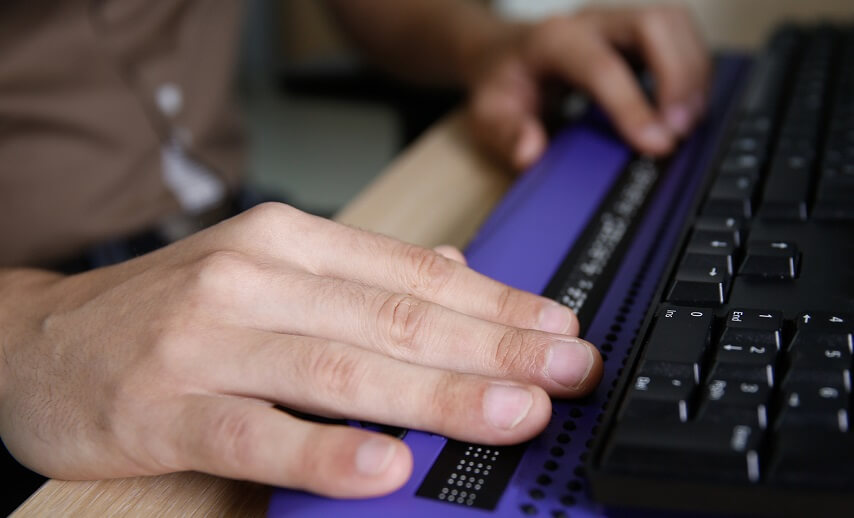What makes a good accessibility tester?
There’s a lot to be said about using an automated tool to scan your site for issues that violate the Web Content Accessibility Guidelines (WCAG) success criteria and other accessibility regulations. Most sites are simply too large and complex to comb through by hand and hope to catch every potential accessibility issue. With that said, there are also some key areas where automation is less than optimal.
When is manual accessibility testing needed?
There are many accessibility issues that cannot be detected by a machine or computer program, which makes manual accessibility audit essential for ensuring that your solutions are actually usable for people with disabilities. This often includes things like keyboard-only commands, compatibility with various assistive technologies, such as JAWS, and coordination with color-adjustment plugins for web browsers. Let’s take a look at a few areas where manual testing is especially useful.
Keyboard-only navigation
The ability to navigate and operate all of a website’s functions without the use of a mouse is essential for many users with disabilities, especially those who use certain assistive tools. Manual accessibility testing can help you determine if your site is optimized for keyboard-only functionality such as:
- Moving between sections of a web page
- Accessing all menus
- Top-of-page links that allow users to skip directly to each page’s vital content
- Links and form fields that can be highlighted using keyboard commands
Screen reader compatibility
Screen readers are among the most commonly used assistive tools for users with low vision, and there are key differences between each of the leading models. Manual testing is useful to determine how readable your content is for various assistive technologies, as many situations—navigating menus, determining where links lead, or understanding the context of alternative text, for instance—are difficult to replicate in an automated setting.
Color adjustments
While automated scans and browser plugins can be helpful in catching problematic color-contrast issues that make comprehension difficult for some users, most of these scans can’t detect contrast ratio images related to background images. Manually testing each area of your website against established standards can help make sure your content is understandable to a broader range of users.
Page titles
The proper use of page titles can be a tricky prospect. While an automated scan can usually identify pages that are missing titles, it can’t determine their context or usefulness. A manual tester can help ensure that titles provide the meaning of the page in a clear, concise way that’s compatible with both assistive technology and search engine crawlers.
Proper coding
Some elements of accessibility are not evident on the consumer side. Ensuring that HTML5 and WAI-ARIA elements are properly employed for maximal accessibility will often require a manual check by someone familiar with coding best practices.
What makes a good accessibility tester?
One of the major benefits of manual accessibility testing is the same as the upside of any kind of editing—getting a new viewpoint on the material. In this case, it’s the difference between computerized scanning and human observation. As advanced as software technology is, there are still plenty of situations where an algorithm can’t recognize the nuances necessary to build a website that works for people of varying abilities.
Manual accessibility testing should be performed by trained professionals with expertise in the subject. Users with experience in keyboard-only navigation, browser plugins, and assistive technology will be able to identify areas where your website is behind the curve and offer solutions.
A manual accessibility tester should also be familiar with the latest standards for online accessibility. Keeping your website compliant with WCAG 2.1 Level AA accessibility standards is the ultimate goal, so employing a tester who understands both the manual needs of disabled users and the internationally respected standards of WCAG 2.0 is essential.
The bottom line for most websites is that the surest path to accessibility is a combination of automated and manual testing. There are just some areas that are handled more efficiently by humans than machines, and vice versa. Automated accessibility checking is ideal for getting a comprehensive overview of accessibility issues across your entire digital presence, while manual testing is needed in cases where issues require human assessment.
As always, it’s important to remember that maintaining an accessible website is an ongoing project. Just as automated scans should be run at scheduled intervals, manual accessibility testing should be a regular part of your website maintenance.
What Disabilities Can a Manual Accessibility Audit Check For?
Manual accessibility testing can test for a wide range of disabilities. Here are a few examples:
Vision Disability
Vision disability is one of the most common disabilities, with color blindness and poor vision ranking high on the list. With accessibility testing, the tester will check if people with disabilities are able to access and use your site in spite of their vision problems.
A manual tester will make sure that the overall color scheme and contrast of colors are friendly for those who are slightly or completely color blind, with poor vision, or with problems with flashing or strobe effects. Moreover, he or she checks if the fonts are readable and simple enough to be easily read by anyone, especially those with disabilities.
Physical Disability
People with disabilities, specifically physical disabilities, may struggle simply to use a computer, let alone navigate through one whole website. Hence, a manual audit will test if the usage of keyboard commands is possible to replicate all the possible functions you can perform with a mouse. This includes functions available in dropdowns, controls, radio buttons, and checkboxes.
Cognitive Disability
While it’s not always obvious, there are people who struggle with understanding complex scenarios. Some disabilities such as cognitive disability manifest through a slow understanding of concepts while some struggle with poor memory.
An accessibility audit will help check commands on a site that requires people to remember certain things like codes or passwords. The testing process also involves checking if all instructions are documented and whether or not they are accessible on all web pages of the site.
Literacy Disability
Literacy disability is a common problem among third-world countries, but it is also a struggle for those diagnosed with this disability.
Audit testing checks if your website contains the right periods and abbreviations for all statements and questions. That also includes checking if there are too many words scattered all around a single page. Needless to say, to make your website WCAG 2.0 compliant, it has to be neat and not have any unnecessary statements that do not serve your content’s purpose.
Hearing Disability
Deafness and the struggle to hear completely and clearly are two auditory disabilities that a manual accessibility audit considers when checking a site.
For the auditor, it is important that a screen reader be able to see the content rather than hear it. This means that instructions using voiceovers and sounds are minimal to none in order to ensure that those with a hearing disability can still easily navigate a website.
Pros and Cons of a Manual Accessibility Audit
A manual accessibility audit is very useful if you want to know an extensive list of improvements that you can make to your website. However, it is not perfect, just as automated tools aren’t able to fully check every aspect of your site. Here are some pros and cons to consider when deciding to use a manual audit.
Pros
- A manual accessibility audit is thorough because it checks for nuances and commands that automated testing software might miss.
- A website is checked against the latest WCAG criteria so that all errors and findings are compared to the newest standards for screen readers.
- Manual audits include human judgment in testing content and design. While automated tools are growing more intelligent as technology improves, they still do not match the ability of an experienced screen reader to judge features and commands.
- Compared to automated accessibility testing, manual accessibility audits give tailor-made solutions for each and every website they check. Instead of giving generic recommendations, the screen readers themselves give specific and guided action items that a site can use to improve on.
Cons
- Manual accessibility testing takes a long time to perform. Since it does not include any automated testing in its process, it can take twice as long as its automated counterpart.
- Results and recommendations are not equally made in a manual audit. This is mainly because they depend on the knowledge and experience of a screen reader. If your website is checked by a seasoned screen reader, then expect to have more recommendations and findings, as they are able to test every function and content.
- You will still need to do automated testing before you do a manual audit. While manual testing is comprehensive, it is still exposed to a human element that makes it prone to errors. While this is not to say that manual audits are often defective, you’ll get better results if you test against an automated testing tool.
Web Accessibility Recommendations
As you consider going through a manual accessibility audit, do not forget to supplement it with an automated audit. Both approaches give you the best recommendations that will help your website become more WCAG-compliant.
If you’re pressed for time, there is no question that automated testing will work for you, but take note that it won’t be a thorough test of all the aspects of your site. If it’s possible for your business to hire an accessibility expert to do manual testing, then this is the best approach. CONTACT ADA SITE COMPLIANCE today for all your website accessibility needs!
Share via:

Speak With An Expert Now
Have a question?
We’re always here to help.
The ADA prohibits any private businesses that provide goods or services to the public, referred to as “public accommodations,” from discriminating against those with disabilities. Federal courts have ruled that the ADA includes websites in the definition of public accommodation. As such, websites must offer auxiliary aids and services to low-vision, hearing-impaired, and physically disabled persons, in the same way a business facility must offer wheelchair ramps, braille signage, and sign language interpreters, among other forms of assistance.
All websites must be properly coded for use by electronic screen readers that read aloud to sight-impaired users the visual elements of a webpage. Additionally, all live and pre-recorded audio content must have synchronous captioning for hearing-impaired users.
Websites must accommodate hundreds of keyboard combinations, such as Ctrl + P to print, that people with disabilities depend on to navigate the Internet.
Litigation continues to increase substantially. All business and governmental entities are potential targets for lawsuits and demand letters. Recent actions by the Department of Justice targeting businesses with inaccessible websites will likely create a dramatic increase of litigation risk.
Big box retailer Target Corp. was ordered to pay $6 million – plus $3.7 million more in legal costs – to settle a landmark class action suit brought by the National Federation of the Blind. Other recent defendants in these cases have included McDonald’s, Carnival Cruise Lines, Netflix, Harvard University, Foot Locker, and the National Basketball Association (NBA). Along with these large companies, thousands of small businesses have been subject to ADA website litigation.
Defendants in ADA lawsuits typically pay plaintiff's legal fees, their own legal fees for defending the litigation, and potential additional costs. In all, the average cost can range from tens of thousands of dollars, to above six figures. There are also high intangible costs, such as added stress, time and human capital, as well as reputational damage. Furthermore, if the remediation is incomplete, copycat suits and serial filers can follow, meaning double or triple the outlay. It's vital to implement a long-term strategy for ensuring your website is accessible and legally compliant.



